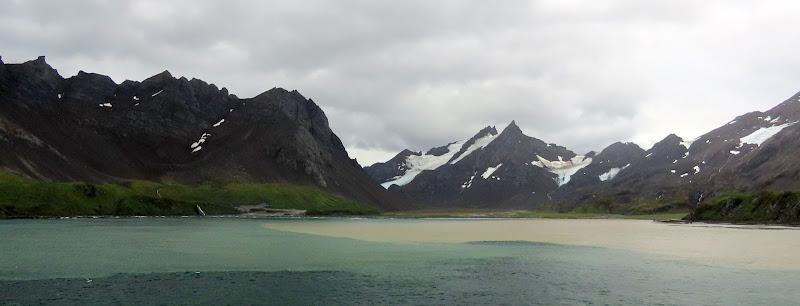Antarctica 2023
SOUTH GEORGIA
Feb 13
GPS Position: 54°09.6’S / 36°42.0’W
Wind: Variable-2 • Sea State: Calm • Weather: Overcast/Rain
Air temp: 7°C • Sea temp: 7°C
We woke up to a rainy foggy day, but we really can't complain after the amazing weather we have had so far.
Today is Whaling Station day!
Stromness Bay

South Georgia has a particularly haunting history associated with whales. Once a British whale-hunting hub, the United Kingdom Overseas Territory of South Georgia is now scattered with the rusted scrap metal of many an abandoned whaling station: Grytviken, Stromness, Leith Harbour, and Husvik recall a past not so distant when whales were hunted in the Southern Ocean with no concern for cruelty or conservation. The near extinction of the Right Whales and other whale species were a direct result of this history.

We spent the night at Husvik harbour, one of the three abandoned whaling stations located in Stromness Bay, which began as a floating factory in 1907 and in 1910 was later expanded into a whaling station. Leith Harbour and Stromness are the two other stations in Stromness Bay. All were linked by a track that ran along the beach and that you can still see today. The station stopped whaling operations in 1960. We can’t visit Husvik due to the asbestos pollution and danger of building collapse.

Like Husvik, Stromness began as a floating offshore whaling station in South Georgia. The shore station was built in 1912, after which the South Georgia Company of Leith used it as a ship repair yard after 1931. Except for Grytviken, Stromness is perhaps the best-known whaling station in South Georgia, due at least in part to its association with Ernest Shackleton’s Expedition, the Stromness whaling station is the place where Shackleton and his 2 companions found help after their journey from Elephant Island.








We land at the beach near Stromness and are greeted by a large group of baby fur seals, as is the tradition in South Georgia. From the beach we can walk the perimeter of the safety zone, though we cannot approach the station due to the risks of airborne asbestos and weakened structures.




From here we have a marshy 5 km hike to go see Shackleton’s Waterfall, the falls that were the last frozen obstacle before Shackleton and his crew could walk to the whale station and get help. It's still raining, but it's not cold.






It's probably about this time that we decided these Muck boots we have been loaned by the company are a purchase we should consider once we get home. In the Marshy mucks, In the snow, in the creeks and wet landings, and even when you have to hike 5 kilometers, they are comfortable and hold up.


Once we got to the falls we had to stop and ponder what it must have been like for Shackleton, Crean and Worsley to climb down this waterfall in mid-winter after having already sailed from Elephant Island and then crossing over South Georgia. From the falls it's a steep hike up to a lookout where you can see the final leg of their journey across the plain and into Stromness. It was a very tough hike up, but once we got there the sun came out, making it all worth it.









On the way back to the beach, one of the older woman walking up has stepped in the marsh and sunk up to her knee, all she says after getting helped out is "this walking is hard work".


A Pippit which was nearly extinct before the rats were eradicated, and a penguin which is now, sadly, extinct
















Our baby seal greeting crew wished us goodbye, and we took a rainy zodiac cruise to the Leith Whaling station.







The largest of the South Georgia whaling stations, Leith Harbour operated from 1909 to 1966. Leith has an interesting history, having briefly been occupied by Argentine special forces who entered the station posed as scrap metal merchants in March of 1982, one of the first events leading to the Falklands War. This South Georgia whaling station, also known as Jericho, also has the distinction of being the last whaling site to be closed in the archipelago. Leith Harbour is too dangerous for landings, so we just cruise on by.










After our cruise we are back on the ship for another bio-security mass-cleansing before arriving in Grytviken, where we will be boarded and inspected. Of the first 100 passengers, 98 of them passed on first inspection.











Looks like the fog might be on its way again, yep, but just for a while.








After lunch we had a South Georgia Heritage Trust presentation, the woman that did the presentation spoke about her history and how she ended up managing the museum on South Georgia for the last few years. We learned that there is approximately 12 people that reside there year round, and how that can grow up to 22 people during the summer months (including the science station).
She did explain how the trust helped eradicate the huge problems they had with rats (escaped from ships), and Reindeer (brought by the Norwegians), both non-native species that were causing decimation of two breeds in particular, the pippits and the yellow-billed pintail (duck). Of course she also pitched how we can help South Georgia, not only by spreading the word about the island and what the Trust does, but by contributing, investing in a hectare, or just shopping at the Gift Shop and Post Office. The other officials stamped our passports and gave us the thumbs up that we were clear to visit Grytviken.




Grytviken Whaling station
We arrived in King Edward cove and passed King Edward Point which is a permanent British Antarctic Survey research station. KEP is the capital of South Georgia and the South Sandwich Islands, the settlement is the smallest capital in the world by population.


One odd sight at the research station is this heavily branded vessel sitting on the site. Apparently it's a one man rowboat, and Antonio de la Rosa planned to row from Chile to Antarctica then do the Elephant Island to South Georgia route we had done. Things did not go as planned, by the time de la Rosa arrived on South Georgia he had travelled 2,380km in 26 days through some of the roughest seas on the planet. He landed at King Edward Point with flooded and malfunctioning equipment, no permit, and no plan on how to leave.


Grytviken is the most well-known whaling station in South Georgia. It's also the most accessible, a long-running Norwegian station operated from 1904 to 1965. It owes much of its fame to the fact that it’s the location of legendary explorer Ernest Shackleton’s gravesite, though this would not have saved Grytviken from near-total abandonment had it not been for major renovations in 2003. While this work dramatically changed the appearance of Grytviken, it also removed the danger of airborne asbestos so common to the whaling stations of South Georgia and allowed for safe visitation. Part of the renovations included the Storehouse, Post Office, Gift Shop and the church. For this landing, the other group was dropped by the Shackleton gravesite, and we were dropped at the main beach, we would each have a couple hours to make it to the opposite landing point.













I'm not sure how to describe my feelings being in this abandoned whaling station. There is bones and remnants of an era where they basically captured and killed everything they could for barrels of whale blubber. Often carcasses and skeletons were just dumped to the side or in the sea, and the smell was described as something horrific. Pelin described her feelings as being somewhere terrible like a concentration camp based on the amount of slaughter that occured here, and I fully understand that feeling.




Nearly extinct, it was pretty cool to see so many yellow-billed pintails here.






The museum was interesting, giving a glimpse into the past, highlighting a lot of the local nature as well as the Shackleton history.








Replica of the James Caird lifeboat that got them to South Georgia




The Norwegian Anglican Church, sometimes known as the Whalers Church, and casually as the Grytviken Church, was pre-built in Norway and erected in Grytviken by whalers around 1912–1913. In 1922, a funeral service for Sir Ernest Shackleton was conducted in the church before his burial amongst 64 others in the church cemetery.







Probably my favourite aspect of this abandoned whale station was seeing how the seals and birds had taken it back.




























The baby seals are still being cheeky, but Norine has a perfect hands-on-hips technique that stops them in their tracks.







We have to carefully and steadily move past a large group of Elephant Seals to get to Shackleton's gravesite.












Grytviken Cemetary/Shackleton's Grave


There's a certain amount of pleasure that comes from seeing baby seals lounging on old whalers graves.





Pelin leads a toast of Shackleton Whiskey to 'The Boss' at Shackleton's grave, you need to save a little in the glass to pour on his grave. I am pretty sure by now that he is well pickled down below after all those that toast to him.

Coming back past Elephant seals, they are a little grumpy if people slow down walking past them. One guide tells us to avoid them in a flattened trail, then another guide says "don't walk there, you don't want to know what it is in that ditch".








Our little beach greeters say goodbye to us for the last time, and we head back to the ship.


Tonight's dinner was a full on BBQ on the outside deck. We had dinner with one of the scientists from the research station… he's a bug scientist from France, we didn't even know there was bugs here. We also got to know two more Israeli guys and our Korean friend.


We asked the scientist about how many ships come in to Grytviken, and he said that almost every day a new ship comes in, but we are the first ship to invite them on board. For days we heard stories from other passengers of the people they met from the research station and employees of the Post Office/museum/gift Shop, so based on the send off they got leaving the ship and the stories that were shared, it was a great success by Oceanwide to have invited them aboard for a BBQ and some drinks.

The after BBQ turned into a dance party until the flashing lights and noise started attracting birds, then it moved inside. A great way to wrap up our Whaling Station Day with some drinks, some laughs and some dancing. We could all use some levity.
Feb 14
GPS Position - 53° 17.4 S, 39° 27.9 W
Wind: NW-3 • Sea State: Moderate • Weather: Cloudy/Sunny
Air temp: 10°C • Sea temp: 7°C
We woke up at the far north of South Georgia in Right Whale Bay and it’s a little overcast but very windy (30-50 knots).

Seals are swimming alongside the boat. With the high winds and crashing swells on the shore, it’s not safe to do a landing, so our one last morning in South Georgia will be as we sail away. Off to the Falkland Islands









It's unfortunate that we can't land here, as there definitely is a large population of penguins on the shore, and I'm sure a bunch of baby fur seals that wanted to say Hi.
As sad as we are that we missed this last landing day, South Georgia was somewhere that will always remain with me. I am so glad that we chose the longer journey that included this stop, it's a very special place.



